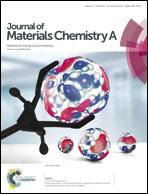High performance and negative temperature coefficient of low temperature hydrogen gas sensors using palladium decorated tungsten oxide
Abstract
Gas sensors based on a noble metal–semiconductor are widely used, and they show a positive temperature response to hydrogen below 400 °C. In this study, a catalytically activated hydrogen sensor is obtained based on Pd decorated WO3 nanoplates constructed by a solvothermal method. An insight into the role of Pd catalyst in the outstanding performance is provided by comparing the sensing properties of this sensor with those of a traditional one made from the same pristine WO3. The pure WO3 sensor exhibits poor selectivity and low sensitivity to hydrogen. In contrast, the observed response of the as-produced sensor is up to 843 at a low operating temperature of 80 °C; the response value is even greater than that of WO3 sensors at high temperatures (250–400 °C). In addition, the Pd-loaded WO3 sensors show excellent selectivity towards H2 in comparison to other common gases (CH4, C3H6O, C2H6, C3H8O and NH3). The significantly improved performance is thoroughly explained in terms of the adsorption–desorption mechanism and chemical kinetics theories. Furthermore, an interfacial model demonstrated in this report indicates that the interfacial barrier between WO3 nanoparticles can be a novel effect for excellent gas sensing performance.


 Please wait while we load your content...
Please wait while we load your content...